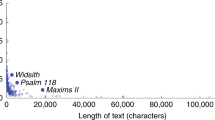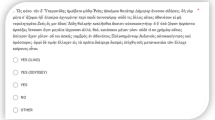Abstract
Application of standard techniques from natural language processing on n-gram models of spelling enables quantification of the similarity between Middle English texts despite their lexical differences. Three studies employing similarity metrics confirm that a scribe’s spelling always is biased in the direction of his exemplars. This bias opens up a window on the number of scribes behind the exemplars for a text executed in a single hand, when other variables such as authorship and poetic form are held constant. A fourth study addresses nine manuscripts of Geoffrey Chaucer’s poem the Canterbury Tales with early textual contents. A one-way ANOVA/Tukey’s Range Test shows that none of these manuscripts is based on exemplars written in more than three hands, when allowance is made for variation due to poetic form. The results point to unified exemplars for the full text as the normal format for the poem’s transmission. The discussion suggests that the final tale ordering found in the first manuscripts is a product of collaboration between the poem’s first two scribes, probably working after Chaucer’s death and spuriously adding the Tale of Gamelyn.
Similar content being viewed by others
References
Benskin, M. & Laing, M. (1981). Translations and Mischsprachen in Middle English manuscripts. In M. Benskin & M. Samuels (Eds.), So meny people longages and tonges: Philological essays in Scots and mediaeval English presented to Angus McIntosh (pp. 55–106). Edinburgh: Middle English Dialect Project.
Benson, L. (Ed.) (1987). The Riverside Chaucer (3rd ed.). Boston: Houghton Mifflin.
Blake, N. (1985). The textual tradition of the ‘Canterbury Tales’. London: E. Arnold.
Blake, N. (1997). Geoffrey Chaucer and the manuscripts of the Canterbury Tales. Journal of the Early Book Society, 1, 96–122.
Blake, N. (2004). Chaucer, Gamelyn, and the Cook’s Tale. In T. Matsuda, R. Linenthal, & J. Scahill (Eds.), The medieval book and a modern collector: Essays in honour of Toshiyuki Takamiya (pp. 87–98). Cambridge: D. S. Brewer.
Blake, N. & Thaisen, J. (2004) Spelling’s significance for textual studies. In C. Dollerup (Ed.), Worlds of words: A tribute to Arne Zettersten (pp. 93–107) [Nordic Journal of English Studies, special issue, 3(1)].
Bliss, A. (1951). Notes on the Auchinleck manuscript. Speculum, 26, 652–658.
Burnley, D. & Wiggins, A. (Eds.) (2003). The Auchinleck manuscript, version 1.1. The National Library of Scotland. http://auchinleck.nls.uk/. Accessed 24 December 2011.
Chen, S. & Goodman, J. (1998). An empirical study of smoothing techniques for language modeling. Technical report TR-10–98, Harvard University. http://research.microsoft.com/joshuago/tr-10-98.pdf. Accessed 24 December 2011.
Cunningham, I. (1972). Notes on the Auchinleck manuscript, Speculum, 47, 96–98.
Da Rold, O. (2003). The quiring system in Cambridge University Library MS. Dd.4.24 of Chaucer’s Canterbury Tales. The Library, 4, 107–128.
Da Rold, O. (2007). The significance of scribal corrections in Cambridge University Library MS. Dd.4.24 of Chaucer’s Canterbury Tales. The Chaucer Review, 41, 393–438.
Doyle, A. (1995). The copyist of the Ellesmere Canterbury Tales. In M. Stevens & D. Woodward (Eds.), The Ellesmere Chaucer: Essays in interpretation (pp. 49–67). San Marino, CA: Huntington Library.
Doyle, A. & Parkes, M. (1978). The production of copies of the Canterbury Tales and the Confessio Amantis in the early fifteenth century. In M. Parkes & A. Watson (Eds.), Mediaeval scribes, manuscripts and libraries: Essays presented to N. R. Ker (pp. 163–203). Aldershot: Scolar Press.
Hanna, R. (1989). The Hengwrt manuscript and the canon of the Canterbury Tales. English Manuscript Studies 1100–1700, 1, 64–84.
Hanna, R. (1996). Pursuing history: Middle English manuscripts and their texts. Stanford: Stanford University Press.
Horobin, S. (1997). A transcription and study of British Library MS Additional 35286 of Chaucer’s Canterbury Tales. Unpublished Ph.D. dissertation, University of Sheffield.
Horobin, S. (2003). The language of the Chaucer tradition. Cambridge: D.S. Brewer.
Horobin, S. (2010). Adam Pinkhurst, Geoffrey Chaucer, and the Hengwrt manuscript of the Canterbury Tales. The Chaucer Review 44(4), 351–367.
Manly, J. & Rickert, E. (Eds.) (1940). The text of the ‘Canterbury Tales’: Studied on the basis of all known manuscripts [8 vols]. Chicago: University of Chicago Press.
McIntosh, A. (1963). A new approach to Middle English dialectology. English Studies, 44, 1–11.
McIntosh, A., Samuels, M., & Benskin, M. (Eds.) (1986). A linguistic atlas of late mediaeval English [4 vols]. Aberdeen: Aberdeen University Press.
Mooney, L. (2006). Chaucer’s scribe. Speculum: A Journal of Medieval Studies, 81, 97–138.
Mooney, L. & Mosser, D. (2004). The hooked-g scribes and Takamiya manuscripts. In T. Matsuda, R. Linenthal, & J. Scahill (Eds.), The medieval book and a modern collector: Essays in honour of Toshiyuki Takamiya (pp. 179–196). Cambridge: D.S. Brewer.
Mooney, L. & Stubbs, E. Scribes and the city: London guildhall clerks and the dissemination of Middle English literature 1375–1425. Woodbridge: York Medieval Press (in press).
Mosser, D. (1996). Witness descriptions. In P. Robinson (Ed.), The Wife of Bath’s Prologue on CD-ROM (n.p.). Cambridge: Cambridge University Press.
Mosser, D. (2008). ‘Chaucer’s Scribe’, Adam, and the Hengwrt project. In M. Connolly & L. Mooney (Eds.), Design and distribution of late medieval manuscripts in England (pp. 11–40). York: York Medieval Press.
Owen, C. (1991). The manuscripts of the `Canterbury Tales'. Cambridge: D. S. Brewer.
Pearsall, D. & Cunningham, I. (Eds.) (1977). The Auchinleck manuscript. London: Scolar Press.
Rickert, M. (1940). Illumination. In J. Manly & E. Rickert (Eds.), The text of the ‘Canterbury Tales’: Studied on the basis of all known manuscripts (vol. 1, pp. 561–605). Chicago: University of Chicago Press.
Roberts, J. (2011). On giving Scribe B a name and a clutch of London manuscripts from c.1400. Medium Aevum, LXXX, 231–254.
Robinson, P. (Ed.) (1996). The ‘Wife of Bath’s Prologue’ on CD-ROM. Cambridge: Cambridge University Press.
Robinson, P. (1997). A stemmatic analysis of the fifteenth-century witnesses to the Wife of Bath’s Prologue. In N. Blake & P. Robinson (Eds.), The Canterbury Tales Project Occasional Papers (pp. 69–132). Oxford: Office for Humanities Communication.
Robinson, P. (2000). Stemmatic commentary. In E. Solopova (Ed.), The `General Prologue' on CD-ROM (n.p.). Cambridge: Cambridge University Press.
Robinson, P. (Ed.) (2004). The `Miller’s Tale' on CD-ROM. Leicester: Scholarly Digital Editions.
Robinson, P. (2006). Witness relations. In P. Thomas (Ed.), The `Nun’s Priest’s Tale' on CD-ROM (n.p.). Birmingham: Scholarly Digital Editions.
Robinson, P. & Bordalejo, B. (2006). Stemmatic commentary. In P. Thomas (Ed.), The `Nun’s Priest’s Tale' on CD-ROM (n.p.). Birmingham: Scholarly Digital Editions.
Robinson, P. & Solopova, E. (1993). Guidelines for transcription of the manuscripts of the Wife of Bath’s Prologue. In N. Blake & P. Robinson (Eds.), The Canterbury Tales Project Occasional Papers (pp. 19–52). Oxford: Office for Humanities Communication.
Runde, E. (2010). Reexamining orthographic practice in the Auchinleck manuscript through study of complete scribal corpora. In R. Cloutier, A. Hamilton-Brehm, & W. Kretzschmar (Eds.), Studies in the history of the English language V: Variation and change in English grammar and lexicon (pp. 265–287). Berlin: Walter de Gruyter.
Rybicki, J. & Eder, M. (2011). Deeper Delta across genres and languages: Do we really need the most frequent words? Literary and Linguistic Computing, 26(3), 315–321.
Samuels, M. (1963). Some applications of Middle English dialectology. English Studies, 44, 81–94.
Scott, K. (1995). An hours and psalter by two Ellesmere illuminators. In M. Stevens & D. Woodward (Eds.), The Ellesmere Chaucer: Essays in interpretation (pp. 87–119). San Marino, CA: Huntington Library.
Seymour, M. (1997). A catalogue of Chaucer manuscripts: Vol. 2: The ‘Canterbury Tales’. Aldershot: Scolar Press.
Stolcke, A. (2002). SRILM: An extensible language modeling toolkit. In J. Hansen & B. Pellom (Eds.), Proceedings of the 7th International Conference on Spoken Language Processing (pp. 901–904). Denver: Casual Productions.
Stubbs, E. (Ed.) (2000). The Hengwrt Chaucer digital facsimile. Leicester: Scholarly Digital Editions.
Stubbs, E. (2007). ‘Here’s one I prepared earlier’: The work of Scribe D on Oxford, Corpus Christi College, MS 198. Review of English Studies 58, 133–153.
Thaisen, J. (2008a). The Trinity Gower D Scribe’s two Canterbury Tales manuscripts revisited. In M. Connolly & L. Mooney (Eds.), Design and distribution of late medieval manuscripts in England (pp. 41–60) York: York Medieval Press.
Thaisen, J. (2008b). Overlooked variants in the orthography of British Library, Additional MS 35,286. Journal of the Early Book Society for the Study of Manuscripts and Printing History, 11, 121–143.
Thaisen, J. (2009). Statistical comparison of Middle English texts: An interim report. Kwartalnik Neofilologiczny, 56(3), 205–221.
Thaisen, J. (in press). A probabilistic analysis of a Middle English text. In B. Nelson & M. Terras (Eds.), Digitizing medieval and early modern material culture (pp. 171–200). Tempe: Arizona Center for Medieval and Renaissance Studies. Also available from Iter: Gateway to the Middle Ages and Renaissance at http://www.itergateway.org.
Thaisen, J. & Da Rold, O. (2009). The linguistic stratification in the Cambridge University Library Dd copy of Chaucer’s Canterbury Tales, Neuphilologische Mitteilungen 110, 295–309.
Thomson, C. (1998). A transcription and study of British Library MS. Lansdowne 851 of Chaucer’s Canterbury Tales. Unpublished Ph.D. dissertation, University of Sheffield.
Vázquez, N. (2009). The ‘Tale of Gamelyn’ of ‘The Canterbury Tales’: An annotated edition. Lampeter: Edwin Mellen Press.
Wiggins, A. (2004). Are Auchinleck manuscript scribes 1 and 6 the same scribe?: Whole-data analysis and the advantages of electronic texts. Medium Aevum, 73(1), 10–26.
Witten, I. & Bell, T. (1991). The zero-frequency problem: Estimating the probabilities of novel events in adaptive text compression. IEEE Transactions on Information Theory 37(4), 1085–1094.
Author information
Authors and Affiliations
Corresponding author
Additional information
To Norman F. Blake.
Rights and permissions
About this article
Cite this article
Thaisen, J. Gamelyn’s Place among the Early Exemplars for Chaucer’s Canterbury Tales . Neophilologus 97, 395–415 (2013). https://doi.org/10.1007/s11061-012-9315-3
Published:
Issue Date:
DOI: https://doi.org/10.1007/s11061-012-9315-3




